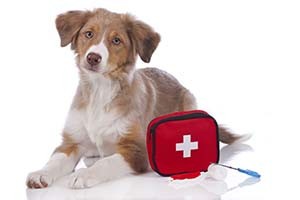If you’ve lived anywhere in the Pacific Northwest for any amount of time you’ve heard to expect and prepare for the “BIG ONE” to hit any day now, but earthquakes aren’t the only emergency that we should plan for. Tragedy can strike without warning. Having a plan in place before an emergency hits is the first step in keeping your loved ones safe. Do you have a plan (and emergency kit) in place that include your pets?
What types of disasters should I consider when making my plan?
- [themify_col grid=”3-1 first”]
- Avalache/Mud SlideBlizzard
- Broken Gas Main
- Building Collapse
- Chemical Spill
- Earthquakes
- Explosion
- Fire
- Flood
- Fuel Leaks/Spills
- Hurricane
- Lightning Strike
- Long-term Power or Water Loss
- Terrorism
- Tornado
- Volcanic Eruption
- Tsunami
Before Disaster Strikes
- Most shelters, including the American Red Cross, do not allow pets due to sanitation regulations.
- Contacts local veterinarians, pet sitters, kennels to see if they will admit your pet should an emergency occur.
- Check local hotels and motels to see if they would allow you to stay there with a pet during an emergency.
What Should I have in my Pet Emergency Kit?

Emergency Supplies
- [themify_col grid=”2-1 first”]
- A Week’s supply of Food for Each Pet
- Can Opener
- 1 Gallon Fresh Water Per Pet
- Collapsible food and water bowls
- Plastic Utensils
- Cleaning Supplies
- Flashlight
- Favorite Toy or Treats
- Spare Collar with ID Tags
- Grooming Items
- Secure Chain and Leash
- Crate or Carrier
- Transistor Radio
- Fresh Batteries
- Pet First Aid Kit
- Paper Towels, Trash Bags, and Baby Wipes
- Digital and paper copies of veterinary and immunization records
- Photo of you and your pets
- Emergency names and numbers
Pet First Aid Kit
- Sterile Gauze Pads and Bandages
- Adhesive Tape
- Bandage Scissors and Tweezers
- Triangular Bandage (muzzle or Sling)
- Alcohol Wipes
- Hydrogen Peroxide
- Antibiotic Ointment
- Sterile Saline Solution
- Cotton Swabs
- Thermometer
- [themify_col grid=”2-1 first”]
- Activated Charcoal Tabs and Maalox
- Plastic Gloves
- Penlight with Fresh Batteries
- Large Towel or Blanket
- Shampoo and Antibacterial Soap
- Name, Address, Phone Number and Hours of Your Veterinarian & Emergency Veterinary Clinic. [/themify_col]
Get additional pet emergency information and disaster planning assistance from:
Federal Emergency Management Agency (FEMA)
Red Rover Responders (Formerly EARS)
Pet Sitters International
American Red Cross









